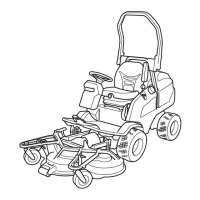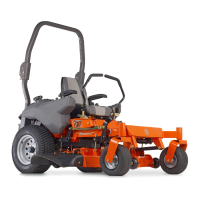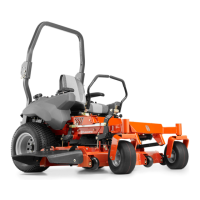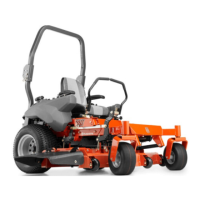Why is my Husqvarna P 520D Lawn Mower releasing white smoke?
- NNeil BeltranSep 3, 2025
If your Husqvarna Lawn Mower is releasing white smoke, it could be due to a defective cylinder in the engine or the engine oil level being too high.

Why is my Husqvarna P 520D Lawn Mower releasing white smoke?
If your Husqvarna Lawn Mower is releasing white smoke, it could be due to a defective cylinder in the engine or the engine oil level being too high.
Why is my Husqvarna P 520D Lawn Mower releasing blue smoke?
If your Husqvarna Lawn Mower is releasing blue smoke, it could be because the engine oil level is too high or the engine is defective.
Why is my Husqvarna P 520D engine not running smoothly?
If your Husqvarna Lawn Mower engine is not running smoothly, several factors could be responsible. The fuel filter might be clogged, or the air filter could be dirty. A blocked fuel tank vent, low feed pressure, or a loose injector pipe could also be the cause. The engine itself, incorrect fuel type, a defective relief valve, fuel injector, injection pump, or feed pump might also be to blame. To address some of these issues, refer to the manual on how to replace the fuel filters and how to clean and replace the air filter.
What to do if my Husqvarna P 520D battery does not charge?
If the battery does not charge, it could be defective or the connection at the cable connectors on the battery terminals is bad. Speak to your Husqvarna service agent if the battery is defective.
Why is my Husqvarna P 520D releasing black smoke?
Black smoke from the product might be due to: A defective fuel injector, incorrect fuel type in the fuel tank, a clogged air filter, or a defective injection pump. Refer to page 31 to clean and replace the air filter.
Why does my Husqvarna P 520D engine have no power?
If the engine seems to have no power, the following reasons may apply: The air filter or fuel filter could be clogged. There might be air in the fuel system. The relief valve or feed pump could be defective. The feed pressure could be too low. The timing of the fuel injection pump might be defective, or the engine itself could be defective. Refer to page 31 to clean and replace the air filter and to replace the fuel filters.
How to fix a Husqvarna P 520D Lawn Mower engine that does not run smoothly?
An engine that doesn't run smoothly may be caused by several factors: The fuel filter or air filter could be clogged. The fuel tank vent might be blocked. The feed pressure could be too low, or the injector pipe might be loose. The engine itself, the fuel type, the relief valve, the fuel injector, the injection pump, or the feed pump could be defective. Refer to page 31 to replace the fuel filters and to clean/replace the air filter.
What to do if my Husqvarna P 520D engine won't start even when the start motor turns?
If the engine doesn't start even when the start motor turns it over, check for these potential causes: There might be no fuel in the fuel tank. There could be air in the fuel system. The ignition cable or the engine itself might be defective. Refer to page 17 to fill fuel.
| Manufacturer | Husqvarna |
|---|---|
| Product Name | P 520D |
| Category | Lawn Mower |
| Fuel Type | Diesel |
| Cutting Width (cm) | 132 cm |
| Drive System | Hydrostatic |
| Transmission | Hydrostatic |
| Blade Engagement | Electric |
| Cutting Width (inches) | 52 in |
| Cutting Width | 52 inches |
| Fuel Capacity (gallons) | 6.5 gallons |
| Weight (lbs) | 1045 lbs |
Information regarding pre-delivery inspection and product identification details.
Details about the P 520D and P 525D models and their intended applications.
Advice on obtaining insurance coverage for the new product.
Labels and numbering of various parts of the P 520D and P 525D models.
Identification of controls and features specific to the P 525D with cabin.
Information on fuse locations and the function of forward/rearward pedals.
Instructions for using the speed catch and lift lever for the cutting deck.
Information about Combi cutting decks and the cabin's air conditioning system.
Explanation of warning symbols found on the product for safety.
Covers warnings for crush injuries, ejecting objects, hot surfaces, and proximity.
Guidelines and warnings for safely cutting grass on slopes.
Explanation of operational symbols, EC directives, and noise emissions.
Details on product liability and definitions of safety warnings used in the manual.
Important safety guidelines for operating the product safely.
Warning about electromagnetic fields and potential interference with medical implants.
Key safety rules to follow during product operation, including awareness of surroundings.
Specific warnings and precautions to ensure children's safety around the product.
Recommendations for using appropriate personal protective equipment during operation.
Recommendations for wearing PPE like hearing protection and protective footwear.
Information on safety devices, their checks, and modifications.
Details on ROPS, safety belt use, and checks for ignition, operation, and speed.
Importance of protective covers and operation of safety signal switches.
Detailed instructions and warnings for safely cutting grass on slopes.
Critical safety advice regarding the handling and use of fuel.
Detailed warnings and precautions for refueling and handling fuel.
Safety measures for handling, charging, and storing the product's battery.
Important safety considerations for transporting the product.
General advice and warnings for product assembly, especially regarding drive belts.
Step-by-step guide for attaching the Combi 132 and 155 cutting decks.
Instructions for attaching Combi 132 X and Combi 155 X cutting decks.
Steps for safely detaching the cutting deck from the product.
Detailed steps for attaching the cabin to the product.
Instructions for attaching and removing the cabin's main and emergency doors.
Steps for securing the cabin and its doors during installation.
Procedure for operating the Roll Over Protection Structure (ROPS) and using the safety belt.
Introduction to operating the product and understanding safety requirements.
Instructions and warnings for safely filling the fuel tank.
Guide for adjusting the seat for forward/rearward position, backrest, and suspension.
Procedure for releasing and applying hydraulic pressure using bypass valves.
Steps for lifting and lowering the cutting deck to mow or transport positions.
Detailed instructions for safely starting the product's engine.
Guide to operating the product, including throttle and speed pedals.
Instructions on how to set and use the speed control catch for different speeds.
How to use the auxiliary lift system to adjust ground pressure.
Steps for adjusting the cutting height for Combi 132 and 155 decks.
Instructions for using the air conditioning system in the cabin.
Procedure for correctly stopping the product's engine.
Instructions for applying and releasing the parking brake.
How to turn the 12V power outlet on and off using the control panel.
Tips and best practices for obtaining optimal grass cutting results.
A schedule detailing daily, weekly, and interval-based maintenance tasks.
List of maintenance tasks with specific intervals for checks and replacements.
Instructions for cleaning the product safely, avoiding high-pressure washers.
Procedure for cleaning the engine's cold air intake grille.
Steps for accessing and removing engine covers for maintenance.
Guidance on cleaning the engine and muffler to prevent fire risks.
Steps for removing various covers for maintenance access.
Procedure for replacing lamps on the product.
Detailed steps for replacing low beam and parking lamps.
Instructions for replacing the turn signal lamps.
Steps for replacing front and rear working light bulbs.
Procedure for replacing the taillight bulbs.
Procedure for checking the functionality of the parking brake.
Steps to check and adjust the alignment of the cutting deck.
Procedure for replacing the main fuel filter.
Steps for cleaning and replacing the air filter cartridge.
Procedure for cleaning and replacing the inlet filter for the air condition.
Guide to identifying and replacing blown fuses for various product functions.
Instructions for charging the product's battery.
Steps for jump-starting the engine using jumper cables.
Recommended tire pressure for optimal performance and safety.
Steps to place the cutting deck in the correct service position.
Procedure for replacing the belt on the cutting deck.
Instructions for adjusting the tension of the PTO belts.
Steps for removing and attaching the BioClip plug.
Procedure for inspecting blades for damage and replacing them.
Instructions for checking the engine oil level using the dipstick.
Procedure for draining and replacing engine oil and oil filter.
Instructions for checking the oil level in the transmission.
Procedure for checking the oil level in the hydraulic system.
Instructions for checking the oil level in the cutting deck's bevel gear.
Procedure for draining and refilling the cutting deck bevel gear oil.
Steps for checking the coolant level in the engine's cooling system.
A visual guide summarizing maintenance tasks at different intervals.
Meaning of symbols used in the quick maintenance guide.
Guidelines for lubricating parts of the product safely and effectively.
Diagnosing and resolving issues where the starter motor does not engage.
Troubleshooting steps for when the engine fails to start or runs unevenly.
Diagnosing and fixing engine overheating problems.
Troubleshooting problems related to black, blue, or white smoke from the product.
Troubleshooting low power and transmission performance problems.
Addressing issues with battery charging and product vibration.
Safety precautions and regulations for transporting the product.
Instructions for safely attaching the product to a trailer using straps and blocks.
Guidelines for towing the hydrostatic transmission product at low speed.
Steps for preparing the product for long-term storage, including fuel stabilization.
Final steps for storage, including emptying fuel and engine oil.
Instructions for safely storing the cabin, considering its weight.
Information on proper disposal of chemicals, parts, and the product.
Specifications for engine, displacement, oil, and cooling system.
Technical data for hydraulic systems and transmissions.
Specifications for the electrical system, battery, and various lamps.
Technical details on cutting deck types, dimensions, and blade specifications.
Measured and guaranteed sound power and pressure levels.
Reported vibration levels on the steering wheel and in the seat.
Diagram and table showing the dimensions of the P 520D and P 525D models.
Diagram and table showing the dimensions of the P 525D with cabin model.
Diagram and table detailing the dimensions for the cabin support structure.
Note that accessory maintenance is covered in separate manuals.
Advice on yearly checks and ordering spare parts.
Details on the transmission warranty and its applicability.
Declaration of compliance with EU directives and applied harmonised standards.











